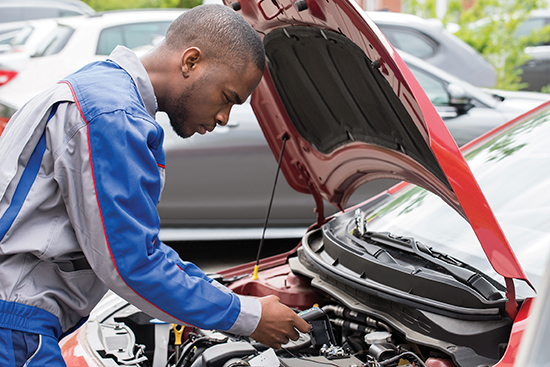4 things to know for National Car Care Month
Your vehicle is a vital piece of transportation for getting you from point A to point B, making it important to keep it in good shape for when you’re ready to ride the roads. While the average American spends plenty of time behind the wheel, there can be periods of time where cars sit in the garage or on the driveway.
Not only can weather impact a vehicle’s performance but so can its usage. A battery not in use will eventually lose its charge. If a car hasn’t gained a lot of mileage over a period of three weeks or longer, the likelihood of a dead battery increases by roughly 50%, according to a study by Interstate Batteries, making it a leading cause of car trouble.
In fact, nearly 1 in 4 car batteries will need to be replaced on the road this year, but more than half of consumers do not test their batteries every year or don’t know if their batteries have been tested, according to the study.
Maintain your battery and your vehicle overall with these tips for safer driving.
- At regular intervals, have your car battery tested at a professional service or repair shop. From phone chargers to built-in security systems, your car battery may power more than you think, and it can place a strain on your alternator. If the alternator can’t keep up, your vehicle relies on the battery to make up the difference, which can cause further strain. Having an external battery charger on-hand can help maintain your car’s power during its off time.
- Regularly check fluid levels, including your coolant and oil, replace air filters and ensure your tires are properly inflated.
- Check to make sure you have your owner’s manual with you either in the glovebox or bookmarked on your smartphone’s browser.
- Replace your jumper cables with a road trip kit containing more practical items, such as a jump box, LED flashlights, first aid kit and duct tape. Jumper cables require another car to power your dead battery and the right positioning to make the cables reach, so a jump box containing a battery and permanently attached jumper cables can be an easier alternative for getting your car back up and running.
Especially when you use your vehicle irregularly, it’s important to practice proper and routine car maintenance so your vehicle is ready when you hit the road again. Find more advice for keeping your car in top condition at InterstateBatteries.com.

What to Do If Your Car Won’t Start
Turn everything off. From electronics and climate control to any other accessories that can be powered down, make sure to turn all of them off. This can make it easier for another car to start yours and can prevent potential damage from voltage surges when power is restored.
Call for help. Roadside assistance is available through some auto insurance policies as well as numerous club memberships. Alternatively, try contacting friends and family, or if you’re parked at an apartment building or in an office complex, its maintenance or security team may be able to help.
Raise the hood and leave it open. This is a universal sign for help that doesn’t use your battery. If you don’t already know, consult your owner’s manual to find where your battery is located. If you find corrosion around the negative terminal, carefully brush it off or knock it loose with a wrench or tire iron. Do not blow on it, as this can result in debris entering your eyes.
Jump-start your car. If possible, use a jump box, which is a compact, rechargeable battery that can jump-start your car. They’re safer and easier than jumper cables and provide a gentler jump-start for your engine.
Photos courtesy of Getty Images
SOURCE:
Interstate Batteries, Family Features
Back To the Oregon Beach Magazine Homepage!

